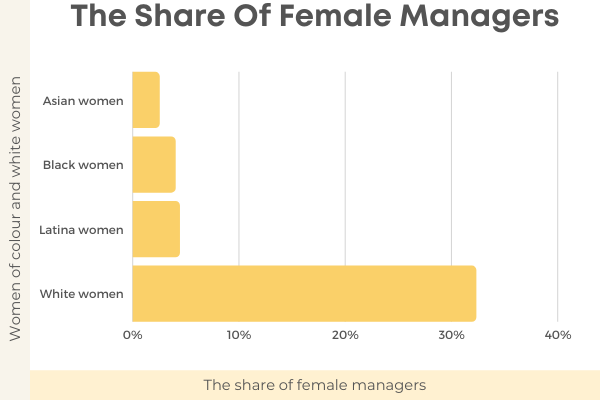Female leadership statistics tell us how many women take up leadership positions.
While there is a lot of room for improvement, these statistics also tell us that we can celebrate women as they take up important roles in business and society.
Let’s find out how many women hold supervisor and CEO positions in business companies and see how women fare as leaders! Time to start reading!
Key Female Leadership Statistics (Editor’s Pick)
- 15% of Fortune 500’s board members are women.
- The number of female CEOs rose by 2% in 2020.
- In 1972, 18% of managers were women, compared to 40% in 2016.
- Only 4% of C-suite leaders are women of color.
20 Female Leadership Statistics
1. Only 15% of Fortune 500’s board members are women.
When it comes to the Fortune 500 companies, boards need more female members. According to the Harvard Business Review, only 15% of Fortune 500’s board directors are women. This number should go up, as women have a lot to offer in the business.
Source: The Harvard Business Review
2. Women scored higher scores than men in 17 out of 19 categories separating good from bad leaders.
When testing women’s against men’s leadership capabilities in 19 categories, women scored higher scores in 17 out of 19 of them. According to a Harvard 360 review, among those categories, women outscored men in collaborating, relationships, and communication.
Source: The Harvard Business Review
3. Under three in 10 senior management positions are held by women.
According to Catalyst, only 29% of senior managers are women in North America. In comparison, Eastern Europe has 35% of women in senior management, and the European Union 30%. Furthermore, the number of women in senior management in Africa is 38%, 27% in Pacific Asia, and 33% in Latin America.
Source: Catalyst


4. Out of Fortune 500 companies, 41 have female leaders.
In 2021, 41 out of Fortune 500 companies had a woman as a chief executive. In comparison, in 2020, this number was 37 out of Fortune 500. Until 2021, that was the all-time high.
Source: Fortune
5. In 2020, the number of female CEOs rose from 5.8% to 7.8%, up by 2%.
In the year that COVID hit the world, the number of female CEOs rose by 2%, compared to 2019. In 2019, there were 5.8% of female CEOs, compared to 7.8% in 2020.
Source: Biz Women
6. From 1972 to 2019, the number of female-owned businesses grew from 4.6% to 42%.
Forty-nine years ago, female-owned businesses were very rare, only 4.6% in 1972. Fast forward to 2019, the share of female-owned businesses rose to 42%, according to female leadership statistics. Since 2014, the number of those businesses grew to almost 13 million or up by 21%.
Source: American Express


7. In 2020, 12.3 million businesses were owned by women and created $1.8 trillion per year in revenues.
In the first year of the COVID-19 pandemic, there were 12.3 million female-owned businesses. However, 30% of them had to temporarily shut down, due to the ongoing pandemic. In comparison, according to OECD, Facebook, and World Bank, 17% of men-owned businesses had to do the same.
Source: Shepherd
8. Women (54.7%) show more resilience in leadership than men (49.3%).
A study by the Harvard Business Review showed that women outperform men in 17 out of 19 categories separating a good from a bad leader. According to that study, women (54.7%) show more resilience than men (49.3%) in leadership.
Source: The Harvard Business Review
9. Between 2015 and 2020, the share of women in senior management grew from 23% to 28%.
A Women in the Workplace 2021 report by McKinsey, between 2015 and 2020 the share of women in senior management went up by 5%, from 23% to 28%. Moreover, in the C-suite, the number of women went up from 17% to 21% in the same period.
Source: McKinsey
10. Women were more successful leaders than men in the government response to the pandemic.
In comparison to men, women-led governments gave a better response to the COVID-19 pandemic. The female leaders of New Zealand, Germany, Iceland, Norway, Denmark, and Finland controlled their country’s response to the pandemic with an under 1% mortality rate, compared to the global rate of 5%.
Source: ScoopWhoop
11. At the top 100 public companies in 2019, 40% of board openings went to women.
At the top 100 public companies in 2019, almost every four in 10 board openings were filled with a female position. While the representation numbers are going up, it will still take time before men and women are more equally represented in jobs.
Source: FOEW
12. In the US, less than one in three startups had at least one woman as a founding member.
Startups in the US (28%) in 2020 had at least one woman as a founding member. That number grew by 2% since 2019. Moreover, in 2018, the number of female founding members of US startups was 24%, and in 2017 it was 22%.
Source: Statista


13. Only 74 women are hired or promoted to managers for every 100 men.
Women are more likely to be stuck in entry positions, compared to men. As a result, more men hold managerial positions than women. According to McKinsey, for every 100 men that get hired or promoted to managers, only 74 women do, too.
Source: McKinsey
14. Around 6.23 million women held managerial positions in the US in 2018, out of 14.9 million American managers.
In 2018, 14.9 million Americans held managerial positions at work. Out of those 14.9 million, 6.23 million were women. In comparison, 8.68 million American men also held managerial positions in the same year.
Source: CompareCamp
15. In 1972, only 18% of managers were female, compared to 40% in 2016.
In under half a century, the share of female managers has grown by 22%, from 18% in 1972 to 40% in 2016. However, there is still a lot of space for progress. For instance, women of color record smaller shares of this number: 2.5% are Asian women, 4% are black women, and 4.3% are Latina women.
Source: Catalyst


16. The only country in the EU with the majority of female managers (53%) is Latvia.
While only 33% of managers in the EU are female, the share of female managers is the highest in Latvia at 53%. This is according to Eurostat statistics on female leadership in the European Union.
Source: Eurostat
17. There are 26 women acting as Heads of State and/or Government in 24 countries.
According to UN statistics on women, only 26 Heads of State and/or Government are women in 24 countries. With this rate, gender equality in executive government positions won’t be reached by another 130 years.
Source: UN Women
18. Almost three in 10 women believe their gender is an obstacle to professional advancement.
According to a 2018 Women in the Workplace report by McKinsey, 29% of women think their gender is an obstruction to their professional advancement in the future. In comparison, 15% of men think the same.
Source: McKinsey
19. Only 4% of C-suite leaders are women of color.
In 2021, according to the Women in the Workplace report, only 4% of C-suite leaders are women of color. Furthermore, according to the same report, this number has not moved significantly since 2018.
Source: McKinsey
20. When women are at the top, companies record 50% higher profits and performance.
One of the keys to better share performance and higher profits is diversity. According to McKinsey, companies record 50% higher profits and performance when women are well-represented at the top.
Source: McKinsey
Final Verdict
To sum everything up, the share of women in leadership is growing, but there are no high-growing rates yet. However, businesses need to realize that women can offer many qualities in leadership that could benefit them. Moreover, other leadership statistics also tell us about the state of leadership now compared to before. When it comes to the workplace, statistics on leadership in the workplace tell us the dynamics between leaders and their employees.


































Find Us on Socials